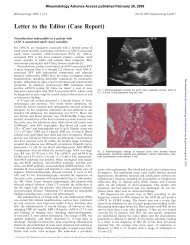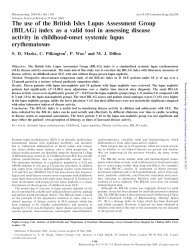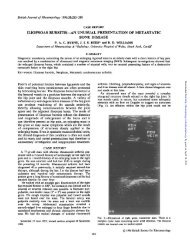Concise report - Rheumatology
Concise report - Rheumatology
Concise report - Rheumatology
Create successful ePaper yourself
Turn your PDF publications into a flip-book with our unique Google optimized e-Paper software.
RHEUMATOLOGY<br />
<strong>Concise</strong> <strong>report</strong> doi:10.1093/rheumatology/keq135<br />
Changing trends in serious extra-articular<br />
manifestations of rheumatoid arthritis among<br />
United State veterans over 20 years<br />
Christie M. Bartels 1,2 , Carolyn L. Bell 1,2 , Kazuhiko Shinki 3 , Ann Rosenthal 4,5 and<br />
Alan J. Bridges 1,2<br />
Abstract<br />
Objectives. The purpose of this study was to examine prevalence trends of serious extra-articular<br />
manifestations (EAMs) in a data set representing both hospitalized and ambulatory patients with RA.<br />
Methods. This retrospective cohort study used serial cross-sectional data to examine the prevalence of<br />
serious EAMs in patients with RA from 1985 to 2006 across the United States (US) Veteran’s Health<br />
Administration system. Serious EAMs included rheumatoid carditis, RA lung disease, FS and pooled<br />
EAM rates included previously <strong>report</strong>ed vasculitis prevalence as queried by ICD-9 searches. Statistical<br />
analysis employed auto-regression and time series analysis using the Chow and Durbin–Watson tests to<br />
detect breakpoints and linear time-trends.<br />
Results. Among 3 million veterans, including >35 000 RA patients annually, we noted declining RA hospitalizations<br />
emphasizing the importance of examining both the inpatient and outpatient settings to assess<br />
EAM prevalence. Individual EAM trends varied, demonstrating linear declines in FS, increases in RA lung<br />
disease and significant breakpoint declines in carditis and pooled serious EAMs. Pooled EAM prevalence<br />
dropped around 2000, from an early linear trend peak of 10% among inpatients, to
Christie M. Bartels et al.<br />
entire national VHA database. The VHA is the largest US<br />
single-payer health system serving 25 million veterans,<br />
caring for 4.2 million in 2001 [4]. Its unique electronic<br />
record has tracked inpatient encounters since 1985 and<br />
outpatients since 1997. Distinctive features of veterans<br />
receiving care include high male gender (>90%),<br />
advanced age (>65 years; 36%), high disability/lowincome<br />
status and high smoking rates [5, 6].<br />
After receiving ethical approval from the University of<br />
Wisconsin Health Sciences Institutional Review Board<br />
(IRB) and the William S. Middleton Veteran’s Hospital IRB<br />
and both authorized a waiver of consent, we searched<br />
nearly 10 million hospitalizations to compare EAM rates<br />
among nearly 3–6000 RA patients hospitalized annually.<br />
Separate analysis examined outpatient EAM rates, encompassing<br />
>38 000 unique RA patients annually (Table 1).<br />
Serious EAMs in this study were defined to include FS,<br />
rheumatoid lung disease, carditis, and pooled rates also<br />
included rheumatoid vasculitis, as described in a previous<br />
<strong>report</strong> [7]. These entities were selected as most serious,<br />
correlating with increased mortality risk [8]. Cases were<br />
identified searching International Classification of<br />
Diseases, Ninth Edition (ICD-9) codes representing the<br />
top 10–13 corresponding diagnoses per encounter for:<br />
RA (714.0); FS (714.1); RA lung disease including interstitial<br />
lung disease (ILD) and pleurisy (714.8, 515.0, 517.8,<br />
511.0 or 511.9, combined with a simultaneous 714.0 code<br />
indicating RA); carditis (714.2); or vasculitis as previously<br />
published [2, 7]. FS and RA carditis were designated by<br />
RA-specific ICD codes. Simultaneous RA diagnoses were<br />
required to accompany codes for designation of RA lung<br />
disease and drug-induced ILD codes were intentionally<br />
excluded.<br />
Individual EAM prevalence derived from dividing the<br />
number of unique individuals with an EAM by the<br />
number of unique RA inpatients and outpatients seen annually.<br />
Statistical analysis employed auto-regression and<br />
time series analysis. Step-wise Chow tests were used for<br />
breakpoint detection and Durbin–Watson analysis assisted<br />
selection of appropriate auto-regression models<br />
that were all ultimately linear. Briefly, Chow analysis<br />
sought to test a single linear regression line null vs two<br />
separate regression lines representing a significant trend<br />
breakpoint during an interval. If model performance improved<br />
when separate interval regression lines were fit,<br />
then breakpoint significance was tested.<br />
Results<br />
The VHA population maintained high age, male representation<br />
and increasing enrolment over all years. Mean age<br />
was 67 years among RA inpatients and 65 years among<br />
outpatients—consistently 5 years older than the total VHA<br />
cohort. Among inpatients and outpatients 92–96% of<br />
veterans with RA were male. All veterans, including RA<br />
patients, were less likely to be hospitalized after 1995,<br />
consistent with initiatives emphasizing outpatient chronic<br />
disease management. TABLE<br />
1 Annual veteran patient totals in respective outpatient and inpatient settings including annual prevalence (shown in parentheses) of serious EAMs<br />
Outpatient Inpatient<br />
RA inpatients FS Pleuritis/ILD Carditis Pooled EAMs a<br />
Total veteran<br />
outpatients, n RA outpatients FS Pleuritis/ILD Carditis Pooled EAMs a<br />
Year<br />
2006 5 078 432 43 347 (0.85) 131 (0.30) 426 (0.98) 277 (0.64) 2274 (5.25) 3369 (0.92) 19 (0.56) 130 (3.86) 10 (0.30) 208 (6.17)<br />
2005 4 998 714 43 670 (0.87) 131 (0.30) 401 (0.92) 255 (0.58) 2157 (4.94) 3249 (0.88) 24 (0.74) 143 (4.40) 10 (0.31) 218 (6.71)<br />
2004 4 871 136 43 655 (0.90) 125 (0.29) 351 (0.80) 330 (0.76) 2134 (4.89) 3189 (0.87) 27 (0.85) 124 (3.89) 16 (0.50) 218 (6.84)<br />
2003 4 692 694 44 560 (0.95) 140 (0.31) 298 (0.67) 430 (0.96) 2024 (4.54) 3218 (0.90) 27 (0.84) 119 (3.70) 18 (0.56) 205 (6.37)<br />
2002 4 434 671 44 129 (1.00) 138 (0.31) 325 (0.74) 480 (1.09) 2091 (4.74) 3112 (0.87) 19 (0.61) 125 (4.02) 23 (0.74) 211 (6.78)<br />
2001 4 052 934 41 791 (1.03 168 (0.40) 261 (0.62) 538 (1.29) 2146 (5.14)* 3139 (0.88) 30 (0.96) 119 (3.79) 22 (0.70) 219 (6.98)<br />
2000 3 640 811 38 961 (1.07) 134 (0.34) 222 (0.57) 593 (1.52)* 2549 (6.54) 3031 (0.86) 30 (0.99) 95 (3.13) 22 (0.73) 246 (8.12)*<br />
1999 3 390 527 38 746 (1.14) 146 (0.38) 238 (0.61) 941 (2.43) 2955 (7.63) 3151 (0.88) 3 (0.98) 129 (4.09) 32 (1.02) 291 (9.24)<br />
1998 3 235 212 37 813 (1.17) 139 (0.37) 210 (0.56) 879 (2.32) 2814 (7.44) 3192 (0.86) 35 (1.10) 135 (4.23) 25 (0.78) 324 (10.15)<br />
1997 2 956 905 37 878 (1.28) 150 (0.40) 212 (0.56) 965 (2.55) 2912 (7.69) 3397 (0.84) 50 (1.47) 128 (3.77) 33 (0.97) 351 (10.33)<br />
Inpatient data for the period 1985–1996 are not shown, whereas inpatient data available from then on are shown. To summarize inpatient data for the period 1985–1996: RA ranged<br />
4136–5832 persons, pooled EAMs ranged 376–585; individual EAM peaks: FS n = 123 (1986), pleuritis/ILD n = 163 (1991), carditis n = 60 (1987). Values are presented as n (%).<br />
a<br />
Vasculitis annual totals previously published [5] are not shown, but included in pooled EAM totals. *Significant breakpoint (P < 0.01) in linear time-trend analysis from time-period<br />
2 www.rheumatology.oxfordjournals.org<br />
ending at the preceding year.<br />
Downloaded from<br />
http://rheumatology.oxfordjournals.org/ by guest on October 24, 2012
FS decline<br />
Beyond an initial step down in FS after 1986, regression<br />
demonstrated a significant linear decline in prevalence<br />
(Table 1 and Fig. 1A). Among inpatients with RA, FS<br />
decreased from 22 to 6 cases per 1000 (roughly >1.5 to<br />
0.5%). From the first outpatient year, 1997, through 2006<br />
the prevalence declined modestly from 4 to 3 per 1000<br />
ambulatory RA patients. Nevertheless, the 25% decrease<br />
among RA outpatients and >3-fold decrease among RA<br />
inpatients demonstrated significant declines in the<br />
prevalence of FS (P = 0.003 and P = 0.000).<br />
RA lung disease increasingly <strong>report</strong>ed<br />
RA lung disease representing pleurisy and rheumatoid ILD<br />
were the only serious EAMs increasingly <strong>report</strong>ed over the<br />
study (Table 1 and Fig. 1B). Specifically, inpatient RA lung<br />
disease in the 1980s ranged from 19 (2%) to 22 (4%)<br />
cases per 1000, and outpatient prevalence rose between<br />
1997 and 2006. ILD, again specifically excluding<br />
Changing RA extra-articular manifestation trends<br />
drug-induced cases, was noted in 2.5%).<br />
Decreased pooled serious EAMs<br />
The pooled prevalence of serious EAMs also declined with<br />
breakpoints between 1999 and 2000 among inpatients,<br />
and between 2000 and 2001 among outpatients (Table 1<br />
FIG. 1Individual serious EAM prevalence versus total RA cases by year (x-axis), circles for inpatient and triangles for<br />
outpatient point prevalence. Note linear declining trend for (A) FSvs linear increase in (B) RA lung disease cases.<br />
Breakpoints noted in (C) rheumatoid carditis demonstrated between 2000 and 2001 among outpatients, and similar<br />
breakpoints demonstrating declines in (D) pooled serious EAMs demonstrated between 2000 and 2001 in both the<br />
inpatient and outpatient settings.<br />
www.rheumatology.oxfordjournals.org 3<br />
Downloaded from<br />
http://rheumatology.oxfordjournals.org/ by guest on October 24, 2012
Christie M. Bartels et al.<br />
and Fig. 1D). Pooled events peaked at 10% for hospitalized<br />
RA patients in the late 1980s. Inpatient EAM events<br />
drifted down to 92 cases per 1000 in 1999, dropped to<br />
81 in 2000 and 62 in recent years. Combined EAMs<br />
among outpatients also significantly declined, dropping<br />
more than one-third from 77 to 50 cases per 1000, just<br />
1 year later between 2000 and 2001 (P < 0.0028).<br />
Discussion<br />
This study examined a large US veteran population with<br />
RA, including both inpatients and outpatients, demonstrating<br />
declines in overall serious EAMs. Only RA lung<br />
disease increased from 1985 to 2006. The demonstration<br />
of simultaneous declines in pooled inpatient and outpatient<br />
EAMs around 2000 raises causal questions including<br />
whether widespread use of DMARDs or the introduction of<br />
biological therapies may have decreased EAMs.<br />
Linear decline in FS after definition change in 1980s<br />
The linear decline in cases of FS since 1987 confirms informal<br />
impressions of clinicians who now rarely encounter<br />
this syndrome. The early Felty breakpoint after 1986<br />
(Fig. 1A) likely reflects reclassification of large granular<br />
lymphoma (LGL) in 1985 [9]. Patients with RA have<br />
3-fold increased risk of lymphoma [10] and this T-cell<br />
lymphoma would have been classified as FS before defining<br />
the LGL subcategory. Nevertheless, declines in <strong>report</strong>ed<br />
FS in the VHA persisted beyond the introduction<br />
of this new diagnostic category, suggesting that FS has in<br />
fact declined beyond the reclassification.<br />
Few prior <strong>report</strong>s on FS prevalence exist. Classic<br />
papers cite a
used throughout the study period in the VHA, though not<br />
routinely audited for payment. A previous <strong>report</strong> cited a<br />
lack of specificity for a single RA code at one VHA facility<br />
[24], and strictly validated administrative search algorithms<br />
require more than one RA code in 24 months [25].<br />
Annual cross-sectional searches did not facilitate<br />
24-month review, likely inflating the RA denominator, but<br />
would not predict a change over time. A previously validated<br />
algorithm was used for RA vasculitis [2], though no<br />
validated algorithms exist for other EAMs. Although validation<br />
was not feasible in this study, it will be important for<br />
future work. One may also question whether deaths would<br />
have differentially identified EAM cases. Identical data<br />
sources were searched reflecting outpatient encounter<br />
or inpatient discharge diagnoses, regardless of survival.<br />
The finding of parallel trends in inpatient and outpatient<br />
encounters suggests that fatalities did not inflate EAM<br />
identification.<br />
Patients were predominantly male, older and tobacco<br />
use was likely higher than most RA cohorts [5], which may<br />
also limit extrapolating results. Likewise, the diagnostic<br />
data set did not contain RA duration, RF or cyclic citrullinated<br />
peptide antibody status, and we did not collect<br />
comorbidity or demographics for multivariate analysis.<br />
Classic <strong>report</strong>s have noted higher EAM rates among<br />
males and smokers [8, 22], perhaps making this an<br />
‘at-risk’ group likely to detect changes. The obvious advantage<br />
of this study was the inclusion of large numbers<br />
of patients in a national health system studied over many<br />
years in both the inpatient and outpatient settings.<br />
In summary, pooled serious EAMs of RA have declined<br />
among US veterans in both the inpatient and outpatient<br />
settings. The timing of declines remained consistent<br />
among inpatients and outpatients and correlates with<br />
timing noted in prior <strong>report</strong>s [2, 3]. Simultaneous breakpoints<br />
in the prevalence of serious EAMs of RA demonstrated<br />
in this study suggest true declines in serious RA<br />
extra-articular disease. Declines in EAMs add credence to<br />
theories that aggressive disease-modifying treatments are<br />
changing the natural history of RA.<br />
<strong>Rheumatology</strong> key messages<br />
. RA serious EAMs (FS, vasculitis and cumulative<br />
EAMs) declined among US veterans over 20 years.<br />
. RA carditis and pulmonary disease prevalence<br />
increased slightly perhaps reflecting recent detection<br />
bias.<br />
Acknowledgements<br />
The authors would like to thank Jennifer Wiegel for assisting<br />
in editing and manuscript preparation. C.M.B. had full<br />
access to all of the data in the study and takes responsibility<br />
for the integrity of the data and the accuracy of the<br />
data analysis.<br />
Funding: The project was supported by<br />
1KL2RR025012-01, awarded through the University of<br />
Wisconsin Institute of Clinical Research KL2 Scholar<br />
Program under 1UL1RR025011 the Clinical and<br />
Translational Science Award (CTSA) program of the<br />
National Center for Research Resources, National<br />
Institutes of Health.<br />
Disclosure statement: The authors have declared no<br />
conflicts of interest.<br />
References<br />
Changing RA extra-articular manifestation trends<br />
1 Turesson C, McClelland RL, Christianson TJ,<br />
Matteson EL. No decrease over time in the incidence of<br />
vasculitis or other extraarticular manifestations in<br />
rheumatoid arthritis: results from a community-based<br />
study. Arthritis Rheum 2004;50:3729–31.<br />
2 Ward MM. Decreases in rates of hospitalizations for<br />
manifestations of severe rheumatoid arthritis, 1983–2001.<br />
Arthritis Rheum 2004;50:1122–31.<br />
3 Watts RA, Mooney J, Lane SE, Scott DG. Rheumatoid<br />
vasculitis: becoming extinct? <strong>Rheumatology</strong> 2004;43:<br />
920–3.<br />
4 Department of Veterans Affairs Office of Public Affairs.<br />
Media relations fact sheet. Washington, DC: Department<br />
of Veterans Affairs, 2002.<br />
5 Bray RM, Marsden ME, Peterson MR. Standardized<br />
comparisons of the use of alcohol, drugs, and cigarettes<br />
among military personnel and civilians. Am J Public Health<br />
1991;81:865–9.<br />
6 Roman J, Perez RL. COPD in VA hospitals. Clin<br />
Cornerstone 2003;5:37–44.<br />
7 Bartels C, Bell C, Rosenthal A, Shinki K, Bridges A.<br />
Decline in rheumatoid vasculitis prevalence among US<br />
veterans: a retrospective cross-sectional study. Arthritis<br />
Rheum 2009;60:2553–7.<br />
8 Turesson C, O’Fallon WM, Crowson CS, Gabriel SE,<br />
Matteson EL. Occurrence of extraarticular disease<br />
manifestations is associated with excess mortality in a<br />
community based cohort of patients with rheumatoid<br />
arthritis. J Rheumatol 2002;29:62–7.<br />
9 Loughran TP Jr, Kadin ME, Starkebaum G et al. Leukemia<br />
of large granular lymphocytes: association with clonal<br />
chromosomal abnormalities and autoimmune<br />
neutropenia, thrombocytopenia, and hemolytic anemia.<br />
Ann Intern Med 1985;102:169–75.<br />
10 Isomaki HA, Hakulinen T, Joutsenlahti U. Excess risk of<br />
lymphomas, leukemia and myeloma in patients with<br />
rheumatoid arthritis. J Chronic Dis 1978;31:691–6.<br />
11 Goldberg J, Pinals RS. Felty syndrome. Semin Arthritis<br />
Rheum 1980;10:52–65.<br />
12 Levin DC, Rao VM, Maitino AJ, Parker L, Sunshine JH.<br />
Comparative increases in utilization rates of ultrasound<br />
examinations among radiologists, cardiologists, and other<br />
physicians from 1993 to 2001. J Am Coll Radiol 2004;1:<br />
549–52.<br />
13 Wislowska M, Sypula S, Kowalik I. Echocardiographic<br />
findings and 24-h electrocardiographic holter monitoring<br />
in patients with nodular and non-nodular rheumatoid<br />
arthritis. Rheumatol Int 1999;18:163–9.<br />
14 Kirk J, Cosh J. The pericarditis of rheumatoid arthritis.<br />
Q J Med 1969;38:397–423.<br />
www.rheumatology.oxfordjournals.org 5<br />
Downloaded from<br />
http://rheumatology.oxfordjournals.org/ by guest on October 24, 2012
Christie M. Bartels et al.<br />
15 Dawson JK, Fewins HE, Desmond J, Lynch MP,<br />
Graham DR. Fibrosing alveolitis in patients with rheumatoid<br />
arthritis as assessed by high resolution computed<br />
tomography, chest radiography and pulmonary function<br />
tests. Thorax 2001;56:622–7.<br />
16 Gochuico BR, Avila NA, Chow CK et al. Progressive<br />
preclinical interstitial lung disease in rheumatoid arthritis.<br />
Arch Intern Med 2008;168:159–66.<br />
17 Brenner DJ, Hall EJ. Computed tomography–an increasing<br />
source of radiation exposure. N Engl J Med 2007;357:<br />
2277–84.<br />
18 Roman J, Perez RL. COPD in VA hospitals. Clin<br />
Cornerstone 2003;5:37–44.<br />
19 Kremer JM, Alarcon GS, Weinblatt ME et al. Clinical,<br />
laboratory, radiographic and histopathologic features of<br />
methotrexate-associated lung injury in patients with<br />
rheumatoid arthritis: a multicenter study with literature<br />
review. Arthritis Rheum 1997;40:1829–37.<br />
20 Lindsay K, Melsom R, Jacob BK, Mestry N. Acute progression<br />
of interstitial lung disease: a complication of<br />
etanercept particularly in the presence of rheumatoid lung<br />
and methotrexate treatment. <strong>Rheumatology</strong> 2006;45:<br />
1048–9.<br />
21 Tournadre A, Ledoux-Eberst J, Poujol D, Dubost JJ,<br />
Ristori JM, Soubrier M. Exacerbation of interstitial lung<br />
disease during etanercept therapy: two cases. Joint Bone<br />
Spine 2008;75:215–8.<br />
22 Cimmino MA, Salvarani C, Macchioni P et al.<br />
Extra-articular manifestations in 587 italian patients with<br />
rheumatoid arthritis. Rheumatol Int 2000;19:213–7.<br />
23 Spigel S. Smoking among veterans. OLR Research Report<br />
2007. http://www.cga.ct.gov/2007/rpt/2007-R-0534.htm;<br />
(6 November 2009, date last accessed).<br />
24 Singh JA, Holmgren AR, Noorbaloochi S. Accuracy of<br />
veterans administration databases for a diagnosis of<br />
rheumatoid arthritis. Arthritis Rheum 2004;51:952–7.<br />
25 Katz JN, Barrett J, Liang MH et al. Sensitivity and positive<br />
predictive value of medicare part b physician claims for<br />
rheumatologic diagnoses and procedures. Arthritis Rheum<br />
1997;40:1594–600.<br />
6 www.rheumatology.oxfordjournals.org<br />
Downloaded from<br />
http://rheumatology.oxfordjournals.org/ by guest on October 24, 2012















